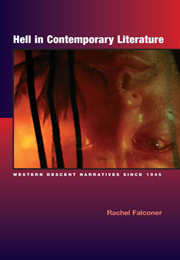Book contents
- Frontmatter
- Contents
- Acknowledgements
- Introduction: Descent and Return – the katabatic imagination
- 1 Hell in Our Time
- 2 Chronotopes of Hell
- 3 Auschwitz as Hell
- 4 Surviving with Ghosts: Second-generation Holocaust Narratives
- 5 Katabatic Memoirs of Mental Illness
- 6 Engendering Dissent in the Underworld
- 7 Postmodern Hell and the Search for Roots
- 8 East-West Descent Narratives
- Epilogue: Katabasis in the Twenty-First Century
- Appendix: Primo Levi, ‘Map of reading’
- Bibliography
- Index
4 - Surviving with Ghosts: Second-generation Holocaust Narratives
Published online by Cambridge University Press: 12 September 2012
- Frontmatter
- Contents
- Acknowledgements
- Introduction: Descent and Return – the katabatic imagination
- 1 Hell in Our Time
- 2 Chronotopes of Hell
- 3 Auschwitz as Hell
- 4 Surviving with Ghosts: Second-generation Holocaust Narratives
- 5 Katabatic Memoirs of Mental Illness
- 6 Engendering Dissent in the Underworld
- 7 Postmodern Hell and the Search for Roots
- 8 East-West Descent Narratives
- Epilogue: Katabasis in the Twenty-First Century
- Appendix: Primo Levi, ‘Map of reading’
- Bibliography
- Index
Summary
Bog-boys and fire-children
In Toni Morrison's Beloved (1987), Sethe is haunted by the flesh and blood ghost of her murdered infant; this ghost is represented as a grown woman who mysteriously surfaces out of the water at the beginning of the novel (p. 50). Like Dante at the bottom of Hell, Beloved exists somewhere between life and death (‘I am not dead I am not’ (p. 213)). Her existence is temporally arrested (‘it is always now there will never be a time when I am not crouching and watching’ (p. 210)). And she is ready to surface from the depths at any point, to remind Sethe (and the reader) of her unjust death and the horrific beginnings of African American history. A number of novels about the Second World War also begin with children rising from graves of mud and fire to haunt the living with their first-hand knowledge of atrocity. William Golding's Darkness Visible (1979) begins in the middle of the London Blitz. His protagonist, a boy later given the name Matty, emerges from a street engulfed in flames: ‘where now, humanly speaking, the street was no longer part of the habitable world – at that point where the world had become an open stove … right there … something moved’ (Darkness Visible, p. 12). So impossible is it that a human child could have survived such conditions that Matty seems to be partly supernatural, a spectre sent directly from Hell. Looking into the flames, a fireman thinks he is looking at ‘a version of the infernal city’ (p. 11).
- Type
- Chapter
- Information
- Hell in Contemporary LiteratureWestern Descent Narratives since 1945, pp. 89 - 112Publisher: Edinburgh University PressPrint publication year: 2004



